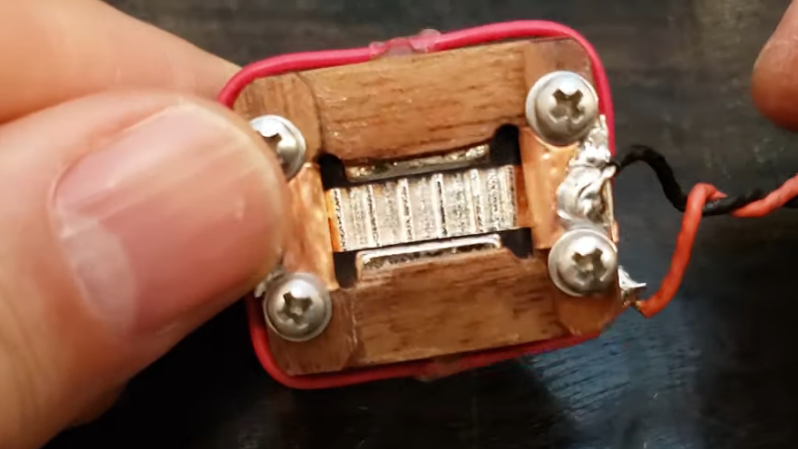Not too many people build their own microphones, and those who do usually build them out of materials like plastic and metal. [Frank Olson] not only loves to make microphones, but he’s also got a thing about making them from wood, with some pretty stunning results.
[Frank]’s latest build is a sorta-kinda replica of the RCA BK-5, a classic of mid-century design. Both the original and [Frank]’s homage are ribbon microphones, in which a thin strip of corrugated metal suspended between the poles of magnets acts as a transducer. But the similarities end there, as [Frank] uses stacked layers of walnut veneer as the frame of his ribbon motor. The wood pieces are cut with a vinyl cutter, stacked up, and glued into a monolithic structure using lots of cyanoacrylate glue. The video below makes it seem easy, but we can imagine getting everything stacked neatly and lined up correctly is a chore, especially when dealing with neodymium magnets. Cutting and corrugating the aluminum foil ribbon is no mean feat either, nor is properly tensioning it and making a solid electrical contact.
The ribbon motor is suspended in a case made of yet more wood, all of which contributes to a warm, rich sound. The voice-over for the whole video below was recorded on a pair of these mics, and we think it sounds just as good as [Frank]’s earlier wooden Model 44 build. He says he has more designs in the works, and we’re looking forward to hearing them, too.















Cyanoacrylate and ear buds – quite disappointed that there was no flames :( or they made them now without cotton?
Is that what happens?
I remember being a young child and trying to use some to glue a fuzzy pipe cleaner for an art project. It produced a wispy white smoke that caused some pretty intense pain when it reached my right eye. Never used it since.
the fluffy cotton gives it a lot of surface so it polymerizes really fast, dumping a lot of heat. Also it seems to like the amide groups, it’s supposed to be the reason it sticks to well to skin ;-)
It’s probably using synthetic cotton.
the open magnetic circuit will make a good antenna for every EM field available…
Well, at least the copper-aluminum batteries are arranged in opposite polarity, so there is no net DC voltage produced.
Still gotta wonder how long this is going to last once someone breathes on it and moisture kicks off the galvanic corrosion.
Maybe he should have used the same copper tape for the ribbon…
Copper’s heavy, hence the aluminum. I think he should use the tedyapo trick from a couple weeks back and solder direct to the aluminum.
My first thought was actually: “Oh, cute, an ironic cargo-cult microphone.”, but there is no iron in it…
So, what’s the magnetic permeability of walnut veneer?
Or maybe the insane strength of the rare-earth magnets makes up for the lack of a magnetic return path.
Could maybe go digging around in some old warehouses in former Hanseatic League cities, and see if you can find a stack of 400 year old lumber in a forgotten corner.. ;-) https://www.history101.com/stradivari-violins-wood-little-ice-age/
Interestingly, the Strad effect seems to be mostly due to placebo. When facing off against modern violins, professional violinists have failed to differentiate the Strads from the modern violins, with results consistently replicated across several studies, which have made the study authors targets of great unhappiness.
https://www.science.org/content/article/million-dollar-strads-fall-modern-violins-blind-sound-check
I wouldn’t be surprised if modern stuff has finally caught up by modelling what Stradivarius could only intuit. Wonder what it looks like as Strad vs the best of the 20th century.
I suspect the placebo / gear snob effect is strong in a huge amount of musical instruments, audio gear, etc… always amuses me the way people get obsessed by having a certain (usually expensive) guitar & amp etc. to replicate their chosen hero when the truth is that good musicians can get a tune out of a plank of wood, and some of the most successful are neither technically accomplished nor using great equipment when they created their “best” work.
I’m not saying crap stuff is as good as decent quality, but there’s definitely a curve of diminishing returns that people somehow believe goes the opposite way.